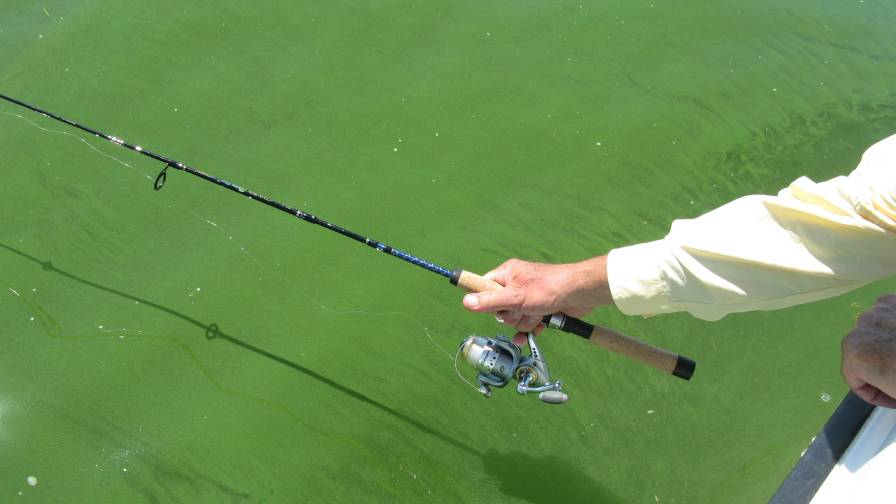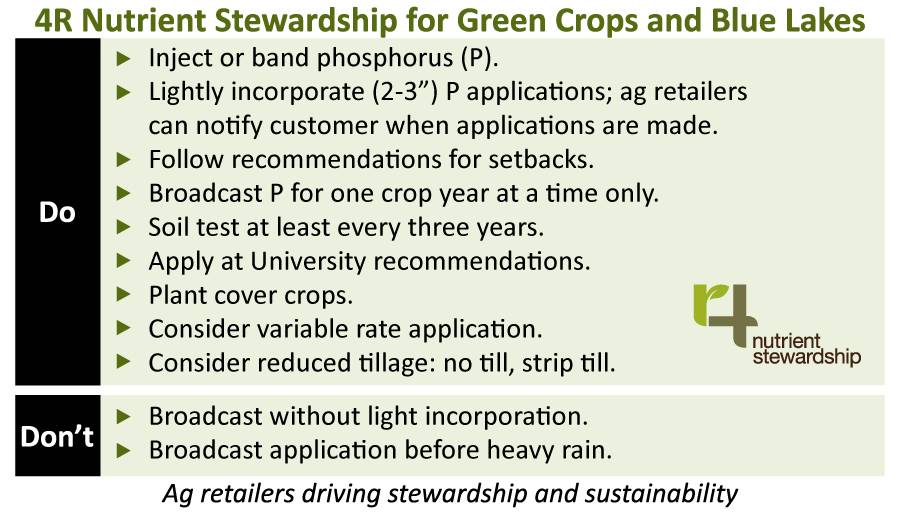Ag Retailers Report Progress on Products and Services that Improve Water Quality
Ag retail-serviced acres of variable rate technology (VRT), cover crops, rotational soil testing, and other phosphorus-saving strategies continue to grow in the Sandusky River Watershed and the Great Lakes Basin. Sixty-two Great Lakes Basin ag retailers participating in the Partnership for Ag Resource Management (PARM) reported 2016 sales of products and services that help keep phosphorus fertilizer on cropland, and out of waterways.

Too much phosphorus in Western Lake Erie feeds algal blooms, which can turn the water pea-soup green by mid-summer. Blue green algae produces a toxin which can make water unsafe to swim and shut down public water delivery.
In the Sandusky River Watershed, where the project began, variable rate phosphorus application increased 19% last year, from 51% to 70% of acreage serviced by participating ag retailers. Based on published study results in scientific journals, the project partners estimate these variable rate acres alone have cut phosphorus losses in the Western Lake Erie Basin by more than one million lbs. Acres with cover crops, which are crops planted in late summer to keep the ground covered over the winter, increased from 10% to 22%. Soil sampling and testing, to determine nutrient levels in the soil, and apply fertilizer accordingly, doubled.
The sales of the products and services promoted by the Partnership have translated to increased profits by ag retailers. A majority of Sandusky retailers reported profits in variable rate phosphorus application, foliar feeding and soil testing, with 100%, 90% and 60% of ag retailers stating profits, respectively. These products and services, many of which fit into the popular 4R framework, represent a “triple win” by providing revenue opportunities for ag retailers, improving net returns for farmers and keeping phosphorus on crop land and out of the water.
“In 2011, we began partnering with ag retailers – all wanted to accelerate contributions to solving the harmful algal bloom challenge in Western Lake Erie,” reports Dr. Thomas Green, who directs the Partnership. “Ag retailers and farmers hunt, fish, boat and swim, and appreciate the need to inform the community, including regulators, on what they are doing voluntarily to solve this thorny problem.”
Twelve retailers initially worked to develop the program to accelerate sales of beneficial products and services. The Partnership team identified those, put tools together to help educate agronomists and farmers, and created an annual on-line survey to track progress in sales, and then translate acres to pounds of phosphorus retained on cropland.
Promotions work authored by the Partnership have included an ongoing free webinar series, with both live and recorded webinars targeting agronomists and featuring experts on specific strategies for reducing phosphorus losses, including cover crop seeding, variety mix and termination options, overcoming phosphorus stratification challenges, strip tillage, manure management and others. Attendance has averaged more than 400 per event. Greg Burris, agronomist at Central Ohio Farmers Co-op in Marion, OH, a participating retailer with the Partnership, responded positively to the series: “I value the webinar subjects offered by PARM,” he said. “They relate to current topics and needs.”
Steve Fenton, Warehouse Operations Manager for Monsanto in central Illinois, commented on one of the Partnership’s webinars released this past July, Cover Crop Seeding Options: What You Need to Know. “I have been viewing webinars regarding cover crops for almost a year. This one was one of the better ones. I think as research continues, the data and information presented in cover crop webinars improves,” Fenton said. “Although cover crops may not be a ‘silver bullet’ in the solution of feeding 9 billion people worldwide by 2050; I’m convinced it is part of the solution.”
The series’ intent is to educate and encourage those in the agribusiness field to think about how profits and stewardship align through the utilization of sustainable products and services available on the market.
Blake Rossel, a certified crop adviser from one of the Partnership’s participating ag retailers, Diversified Agri-Services in McCutchenville, OH, is part of a business that relies heavily on an ever-evolving market. Education on current trends and innovations in the agriculture sector can help keep retailers relevant in a competitive field. “It’s the responsibility of all ag dealers to keep up to date on the latest technology and nutrient trends,” Rossel said. “Best for both the dealer and grower.”
 |
The Partnership provides several educational resources for ag retailers, agronomists, and farmers, including the webinar series, available on the Partnerships website, along with news updates on the homepage, free phosphorus-loss-reduction wallet cards, and an updated agronomist handbook. The handbook contains updated fact sheets for agronomists and farmers on topics such as foliar feeding, soil sampling, phosphorus loss, strip till and more. Educational tips on 4R nutrient management and phosphorus loss reduction are outlined on the wallet cards, which can be ordered on the website, free of charge. More than 7,000 wallet cards were distributed in the Great Lakes Basin last year.
Sally Flis, Director of Agronomy at The Fertilizer Institute in Washington, DC, has found the Partnership’s wallet cards cater to much of the findings listed by the 4R Research Fund. “Combining conservation practices and P fertilizer incorporation, listed on the wallet card as ‘Do’ are supported by work from the 4R Research Fund that have found use of conservation practices with P fertilizer incorporation controls P losses better than fertilizer rate reductions,” she said. The Partnership continues to promote best management practices to reduce nutrient loading in waterways, and works to develop programs and technologies that support soil health and clean water.
In 2016, the Partnership established a cost-share program for farmers who have not yet tried VRT for phosphorus applications. “Ag retailers know who those farmers are, and can readily identify and recruit those customers to try up to 100 acres free of charge,” describes Mark Adelsperger, resource specialist for the project. “Administering the program through ag retailers makes it very efficient, plus we can readily capture what farmers do as a result of their free trial. Results so far support that farmers stick with it, and expand VRT to more acres.”
Funding for the cost share program has been provided by US EPA through the Great Lakes Restoration Initiative. Currently, the program has 37 ag retailer participants enrolled with 10,000 acres, and another 10,000 acres have been allotted for the 2019 year and are open for enrollment.
The Partnership believes that succeeding in reducing phosphorus losses and increasing BMP use among those in the field is a collaborative effort between multiple stakeholders. “Pre-competitive industry collaboration to address common challenges is an incredible tool to help move the needle forward for everyone,” Dr. Green reports. “The response from ag retailers has been tremendous, and our next survey will be expanded to other opportunities including reducing nitrogen losses, delaying pesticide resistance and improving pest management results. Participation will be open to retailers anywhere, not just the Great Lakes Basin.”
The Partnership has been supported by a grant from the Great Lakes Protection Fund, with additional support from participating ag retailers, USDA NRCS and the National Fish and Wildlife Foundation. Ag retailers interested in participating anywhere in the U.S. or Canada can contact Adelsperger at [email protected]. Find a list of the Partnership’s current ag retailer participants on our website.







